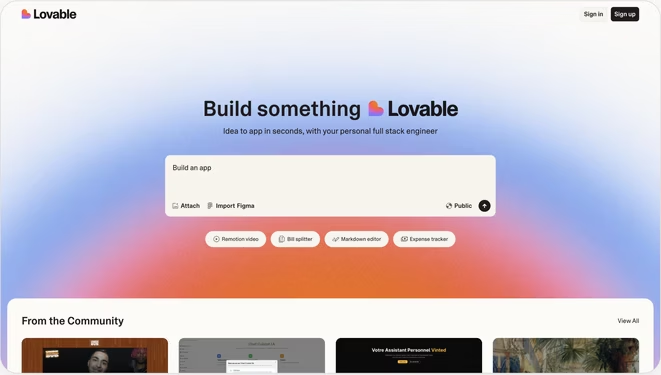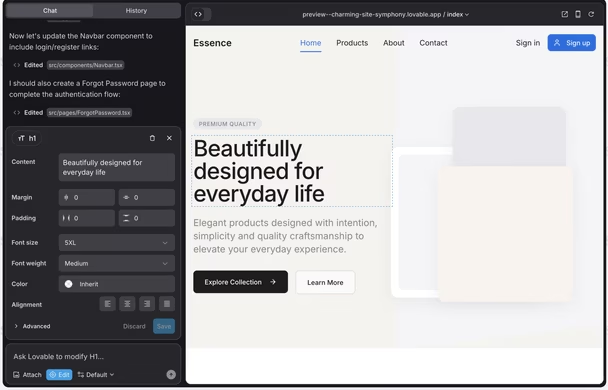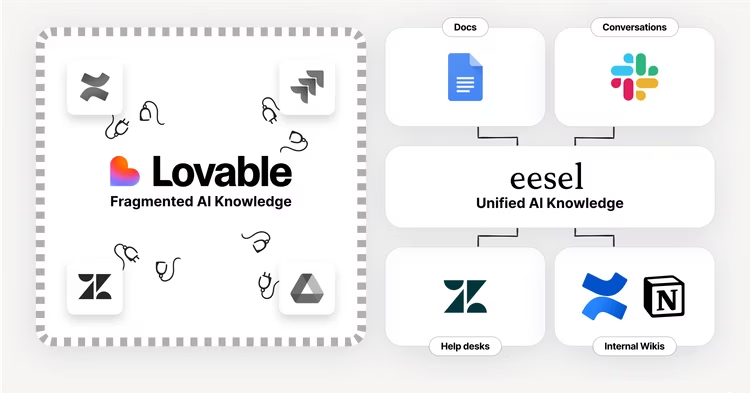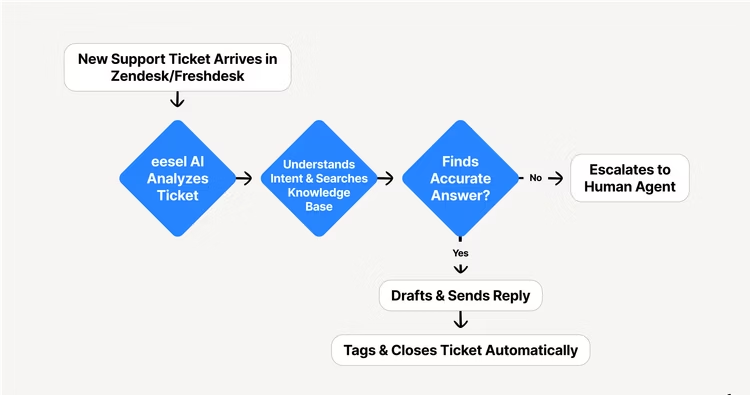The AI revolution is no longer a distant promise; it’s a present-day gold rush. For developers, entrepreneurs, and content creators, the race is on to build the next generation of intelligent applications. However, the complexity of integrating AI models, managing data, and deploying scalable apps has been a significant barrier. This is where our Lovable reviews begin. Lovable emerges as a powerful contender, promising a no-code/low-code platform that democratizes AI app development.
But does it deliver? Is the Lovable app builder the tool you need to bring your idea to life, or is it another platform that overpromises and underdelivers? This in-depth review will dissect the lovable app, explore its features, analyze the lovable pricing structure, and provide an honest verdict for AI app creators like you.

What is Lovable? An In-Depth Look at the AI App Builder
At its core, Lovable (often misspelled as loveable) is a visual development platform designed specifically for creating and deploying AI-powered applications. Unlike traditional development, which requires deep expertise in programming languages (like Python) and machine learning frameworks, Lovable offers a drag-and-drop interface.
This platform acts as the “glue” that connects three critical components:
- Your User Interface (UI): What your user sees and interacts with.
- Your Data: The knowledge base your AI will use (e.g., documents, websites, APIs).
- AI Models: The “brain” of your operation (e.g., GPT-4, Claude 3, or other open-source models).
The primary goal of the lovable app builder is to drastically reduce development time and technical overhead. Instead of writing thousands of lines of code to handle API calls, manage data pipelines, and build a front-end, you can visually construct workflows. This answers the fundamental question of “what is Lovable?”—it’s an accelerator for building sophisticated AI tools, from simple chatbots to complex data analysis dashboards.

Lovable Review: Key Features and Capabilities
To truly understand its value, our Lovable review must dive deep into its core features. This isn’t just a simple tool; it’s an ecosystem for creation.
Intuitive Drag-and-Drop Interface
The main selling point is its accessibility. You can build your app’s front-end by dragging components like text boxes, buttons, and data tables onto a canvas. This visual-first approach is perfect for product managers, designers, and entrepreneurs who want to prototype and build functional apps without a dedicated engineering team.
Powerful AI Model Integration
Lovable isn’t an AI model itself; it’s a connector. It allows you to plug into industry-leading models from OpenAI, Anthropic, Mistral, and others. This is a crucial advantage.
- No Vendor Lock-in: You can swap models as new, better ones are released.
- Prompt Chaining: You can visually build complex “chains of thought” for your AI, where the output of one prompt becomes the input for the next.
- Context Management: Easily connect your own data sources (PDFs, websites, Notion databases) to provide context for the AI, enabling it to answer specific questions about your business or documents.
Custom Workflow and Logic Automation
This is where the lovable app builder truly shines. You can create complex business logic visually. For example:
- A user fills out a form (Trigger).
- Lovable sends that data to an AI model to be summarized (Action 1).
- The summary is then cross-referenced with an internal database (Action 2).
- Finally, the result is displayed to the user and an email notification is sent (Action 3 & 4).
Building this “agent” or workflow from scratch would take days. In Lovable, it can be done in hours.

Seamless Data Handling and Deployment
Lovable provides built-in tools for managing your data, including vector databases which are essential for AI “memory” (Retrieval-Augmented Generation, or RAG). Once your app is built, you can deploy it with a single click. Lovable handles the scaling, server management, and backend infrastructure, allowing you to focus on your app’s functionality, not its lovable status or uptime.
How Does the Lovable App Builder Work? A Step-by-Step Guide
For those new to the platform, here’s a simplified walkthrough of the creation process.
- Sign Up & Project Setup: The first step is the
lovable ai loginprocess, which is a standard email and password registration. Once in, you’ll create a new project. - Build Your UI: You’ll start by dragging components onto the canvas to create your app’s interface. This could be a chat window, a form, or a complex dashboard.
- Connect Your Data: Upload your documents, connect to an API, or link a database. This will be the “knowledge” your AI uses.
- Configure Your AI Logic: This is the “magic.” You’ll use the workflow editor to tell the AI what to do. For example: “When a user types in the chatbox, take their text, search the connected database for relevant info, and then use GPT-4 to generate a natural-language answer.”
- Test and Deploy: Lovable provides a “preview” mode to test your app instantly. Once you’re satisfied, you can deploy it to a live URL to share with the world or embed on your website.

Lovable Pricing: Is It Worth the Investment?
A critical part of any lovable reviews is the cost. The lovable pricing model is typically tiered, designed to scale with your usage. While specific plans may change, the structure generally looks like this:
- Free Plan / Trial: Often available, this plan lets you build and test applications with limited resources (e.g., fewer AI “credits,” limited user access). It’s perfect for learning the platform.
- Pro Plan (for Individuals/Startups): This is the most common paid tier. It unlocks more AI credits, custom domains, more data storage, and the ability to have more end-users for your app. The
lovable dev pricingat this level is designed to be accessible for serious builders. - Business / Enterprise Plan: For large-scale applications with high traffic, advanced security needs (like SSO), and dedicated support. This plan offers bulk usage rates and enterprise-grade features.
Is it worth it?
Consider the alternative: hiring a machine learning engineer, a backend developer, and a frontend developer. The combined salaries for such a team can easily exceed $300,000 per year.
Lovable’s pricing, in contrast, turns this massive capital expenditure into a predictable operational expense. For a startup or an individual creator, the return on investment (ROI) is clear: you can launch a functional, AI-powered product in a fraction of the time and at a fraction of the cost.
For more insights into building and monetizing AI tools, you can explore our development blog.
Pros and Cons: An Honest Lovable Review
No platform is perfect. A balanced review must acknowledge both its strengths and its potential weaknesses.
Key Takeaways: Lovable Pros & Cons
Advantages (Pros)
- Speed to Market: This is Lovable’s biggest win. You can go from idea to functional MVP (Minimum Viable Product) in days, not months.
- Accessibility: It empowers non-technical founders, product managers, and designers to build powerful tools without writing code.
- AI Flexibility: The ability to easily integrate and swap out best-in-class AI models is a massive strategic advantage.
- Managed Infrastructure: You don’t need to be a DevOps expert. Lovable handles scaling, security, and uptime (
lovable status).
Limitations (Cons)
- The “No-Code” Ceiling: For extremely complex or unique backend logic, you may eventually hit limitations that only custom code can solve.
- Learning Curve: While “no-code,” it’s not “no-learning.” You still need to understand database logic, API structures, and prompt engineering.
- Platform Dependency: You are reliant on their pricing, features, and
lovable status.

Who is Lovable For? (And Who It’s Not For)
Understanding the target audience is key.
Lovable is an excellent choice for:
- Startups & Entrepreneurs: Quickly build and test an AI-powered MVP before investing heavily in an engineering team.
- Product Managers & Designers: Create functional prototypes and internal tools to solve company problems without pulling developer resources.
- Content Creators & Marketers: Build custom AI tools for your audience (e.g., “AI Blog Post Idea Generator,” “SEO Content Analyzer”) as lead magnets or paid products.
- “Citizen Developers” within large companies who need to automate specific department workflows.
Lovable might not be the best fit for:
- Large-Scale, High-Performance Systems: If you’re building the next Twitter or a high-frequency trading bot, you’ll need a custom-coded backend.
- Deep AI Model Researchers: If your goal is to build and train new foundation models from scratch, this is not the tool for that. Lovable uses models; it doesn’t create them.
Lovable vs. The Competition (e.g., Trickle, Eesel)
The AI app builder space is exploding. When looking at competitors mentioned in other reviews, like Trickle or Eesel, the differentiation often comes down to focus.
- Some platforms might excel at agent-based automation (like AI employees) but have weaker UI-building capabilities.
- Others might be fantastic at internal tool building but struggle with public-facing, multi-tenant applications.
Lovable aims to be an all-in-one solution, balancing a strong visual UI builder with a robust, visual AI workflow and logic editor. This makes it one of the more versatile platforms on the market, capable of building both internal tools and full-fledged, public-facing AI apps.
Getting Started: Your Guide to the Lovable AI Login and Careers
Getting started is straightforward. The lovable ai login page is the gateway. We recommend starting with the free trial to get a feel for the interface. Build a simple “Hello, World!” AI app to understand the basic mechanics.
Furthermore, it’s always a good sign to check a company’s health. The Lovable Careers page (if public) often shows a growing team, which indicates a healthy, investing, and evolving platform. A company that is hiring is a company that is building new features and providing better support.
Explore case studies of no-code app development on TechCrunch

The Verdict: Is Lovable the Future of AI App Development?
After this extensive Lovable review, our verdict is clear: Lovable is a game-changer for its target audience.
It successfully abstracts away the most painful parts of AI development—the infrastructure, the complex integrations, and the frontend code. It empowers a new wave of creators to build and launch sophisticated AI applications that would have been impossible just a year or two ago.
While it has a learning curve and isn’t the solution for every possible use case, its blend of power, flexibility, and (relative) ease of use makes it a top-tier contender in the no-code AI space. If you are an entrepreneur, product manager, or creator looking to build an AI app, Lovable should be at the very top of your list to evaluate.
The best review, however, is your own. The platform’s real power is only understood by using it.
Review this article again or Return to our homepage.
Ready to build your own AI application?
Don’t just take our word for it. The best way to understand the power of Lovable is to try it yourself. Click the link below to sign up and start building your first AI app in minutes.
Click Here to Sign Up for Lovable and Start Building Today!Conclusion
In summary, this Lovable review finds the platform to be a powerful and transformative AI app builder. It provides a robust, visual environment for creating, testing, and deploying everything from simple AI agents to complete, customer-facing applications. By handling the complex backend and infrastructure, Lovable empowers creators to focus on what truly matters: building value and solving problems with AI.
The era of waiting for technical co-founders or massive engineering budgets to test an idea is over. The time to build is now.